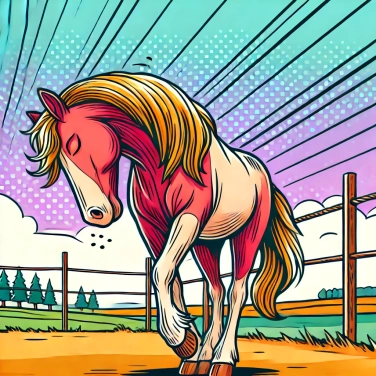Horses can sleep standing up thanks to an automatic locking system in their joints, which allows them to rest while remaining standing to quickly escape in case of danger.

Horses have a specialized anatomy with sturdy limbs capable of efficiently supporting their weight without constant muscular effort. Their strong tendons and ligaments form a kind of natural hammock system that keeps their joints in place without fatigue. Thanks to well-adapted muscle groups, particularly in the hind legs, body weight remains balanced, allowing horses to doze quietly while standing without falling and conserving their energy.
To sleep standing up, the horse uses an anatomical trick called the stay apparatus. Essentially, it is a set of tendons and ligaments located in the legs, capable of tightening and locking like an automatic locking mechanism. With this, the joints of the limbs lock in a vertical position without muscular effort, allowing the horse to completely relax while remaining standing. The horse can thus take a short nap, legs locked, without the risk of falling. Quite an ingenious system!
Horses sleep in a fragmented manner, accumulating short naps throughout the day and night, rather than having one long continuous sleep like we do. They spend the majority of their resting time in light sleep, mainly standing, to maintain a state of minimal alertness while remaining attentive to potential predators. However, they still need phases of deep sleep, during which they typically lie down for only a few minutes. During these phases, the horse is completely relaxed, often losing muscular control and may even start to snore or move its legs as if galloping. These periods of deep sleep remain short and infrequent, but they are essential for complete rest and proper brain function.
Sleeping standing up allows horses to remain constantly on alert. And in the wild, it's better to avoid being caught off guard during a nap by a predator like a wolf or a puma. This posture also gives them the advantage of being able to take off quickly, without losing a fraction of a second to get back on their feet. Consequently, this ability to sleep standing up is a true survival strategy, essential for horses living in the wild.
Sleeping while standing allows horses to react very quickly in case of danger, an evolutionary advantage inherited from their wild ancestors who were constantly exposed to predation.
A solitary horse experiences much more difficulty entering deep sleep because it heavily relies on the reassuring presence of other companions to feel completely secure.
Foals sleep much more often lying down than adults do because they spend more time in deep sleep to promote their rapid growth and brain development.
Even though horses can sleep standing up due to their locking mechanism in the joints, they must lie down in order to reach the deep sleep phase known as REM (Rapid Eye Movement).
No, thanks to their joint locking mechanism called the "stay apparatus," horses can sleep standing up without the risk of falling.
Yes, when they reach REM sleep, which occurs exclusively when they lie down, horses can have dreams similar to those of other mammals.
A horse that sleeps standing will be stationary, with one hind leg slightly bent, a lowered head, half-closed eyes, and a relaxed lower lip.
Horses are prey animals; their short and fragmented sleep is an adaptation that allows them to remain alert to potential predators in their natural environment.
On average, a horse sleeps between 3 and 5 hours a day, divided into short periods of light or deep sleep. Only short periods of sleep are spent lying down.
No, horses also sleep lying down, especially to reach deep sleep (paradoxical sleep). Sleeping standing up allows for light rest while remaining alert to their environment.

No one has answered this quiz yet, be the first!' :-)
Question 1/5